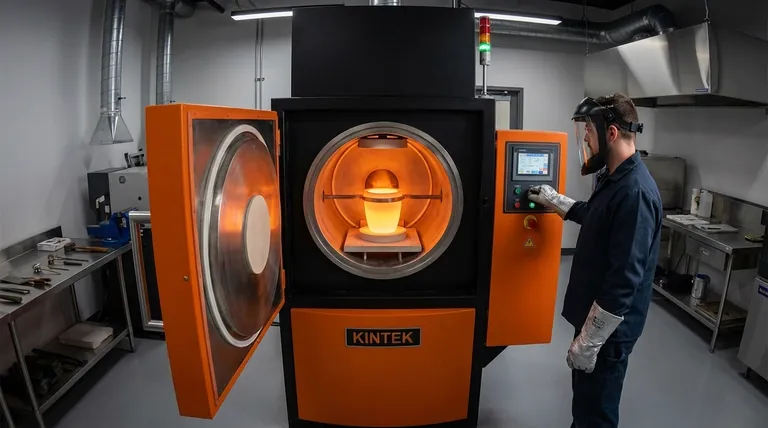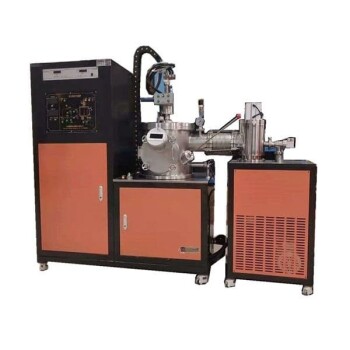Yes, you can absolutely melt gold in an induction furnace. This technology is not only capable of reaching the necessary temperatures but is exceptionally well-suited for the task. Induction furnaces offer a clean, efficient, and highly controllable method for melting a wide range of metals, including precious metals like gold.
The core principle of induction heating is its ability to generate heat directly within the metal itself, rather than applying external flames or heating elements. This makes it an extremely precise and versatile technology, ideal for everything from industrial steel production to high-purity precious metal applications.

How Induction Furnaces Melt Gold
An induction furnace doesn't use fire or traditional heating elements. Its operation is based on fundamental principles of electromagnetism, making it a highly advanced and controlled process.
The Principle of Electromagnetic Induction
An induction furnace uses a coil of conductive material, typically copper, through which a powerful alternating electrical current flows. This current generates a strong, rapidly changing magnetic field around the coil.
Inducing Heat Directly in the Metal
When a conductive material like gold is placed within this magnetic field (typically inside a container called a crucible), the field induces powerful electrical currents, known as eddy currents, directly within the gold. The natural electrical resistance of the gold causes these currents to generate intense, rapid heat.
Unmatched Speed and Precision
This method heats the metal from the inside out. It is incredibly fast and allows for precise temperature control, which is critical for preventing overheating or contamination when working with valuable materials like gold and other precious metals.
The Broader Capabilities of Induction Technology
The ability to melt gold is just one application of this versatile technology. Induction furnaces are used across countless industries because of the wide spectrum of materials they can process effectively.
Ferrous and Non-Ferrous Metals
Induction furnaces are workhorses in foundries for melting ferrous metals like iron and steel, as well as non-ferrous metals such as copper, aluminum, and brass.
High-Temperature and Refractory Metals
Because they can generate extremely high temperatures, these furnaces are also capable of melting refractory metals and creating specialized superalloys. Materials like nickel-base, cobalt-base, and stainless steel are commonly melted using this method.
Specialized Vacuum Environments
For metals that react easily with oxygen or nitrogen, a vacuum induction furnace can be used. This specialized equipment melts the material in a vacuum, preventing unwanted chemical reactions and ensuring the purity of materials like ultra-high-strength steel or magnetic alloys.
Understanding the Trade-offs
While powerful, induction technology involves specific considerations that are important to understand for any practical application.
The Critical Role of the Crucible
The metal is melted inside a crucible, a non-conductive container that must withstand extreme temperatures without reacting with the metal. The choice of crucible material is critical to prevent contamination of the final product.
Matching the System to the Material
The furnace's operating frequency and coil design are engineered for specific types and quantities of metal. A system designed to melt tons of steel will not be efficient for melting a small amount of gold, and vice versa. Proper system matching is key to performance.
Initial Investment vs. Operational Efficiency
Induction furnaces represent a significant upfront investment compared to traditional fuel-fired furnaces. However, they often provide long-term savings through higher energy efficiency, faster melt times, and greater process control.
Making the Right Choice for Your Application
To determine if an induction furnace is the correct tool, consider your primary objective.
- If your primary focus is high-purity precious metal melting: Induction heating is the superior choice due to its speed, cleanliness, and precise temperature control, which minimizes contamination and material loss.
- If your primary focus is creating specialized alloys: The controlled environment of an induction furnace, especially a vacuum model, provides the necessary precision to produce complex and highly pure alloys.
- If your primary focus is large-scale industrial melting: For common metals like iron, steel, or copper, induction furnaces offer excellent energy efficiency and operational control for high-volume production.
Ultimately, induction technology provides a powerful and precise tool for melting metals, making it an excellent choice for applications ranging from industrial foundries to high-value gold casting.
Summary Table:
| Feature | Benefit for Gold Melting |
|---|---|
| Direct Internal Heating | Heat is generated within the gold itself, preventing external contamination and ensuring purity. |
| Precise Temperature Control | Allows for accurate melting points, preventing overheating and material loss. |
| Fast Melting Times | Rapid heating from the inside out increases efficiency and throughput. |
| Clean Process | No flames or combustion byproducts, making it ideal for high-value materials like gold. |
| Versatility | Capable of melting a wide range of metals, from gold to specialized alloys. |
Ready to achieve superior purity and efficiency in your gold melting process?
At KINTEK, we specialize in high-performance lab equipment, including induction furnaces designed for precise precious metal processing. Our solutions ensure minimal contamination, maximum yield, and reliable operation for all your laboratory needs.
Contact our experts today to find the perfect induction melting system for your gold and precious metal applications!
Visual Guide

Related Products
- Vacuum Arc Induction Melting Furnace
- Lab-Scale Vacuum Induction Melting Furnace
- Vacuum Heat Treat Furnace and Levitation Induction Melting Furnace
- 1400℃ Laboratory Quartz Tube Furnace with Alumina Tube Tubular Furnace
- 1700℃ Laboratory Quartz Tube Furnace with Alumina Tube Tubular Furnace
People Also Ask
- What is a remelting process? A Guide to High-Purity Metal Refinement
- How does vacuum arc remelting work? Achieve Ultra-Clean, High-Performance Metal Alloys
- What is the process of vacuum arc remelting? Achieve Ultimate Purity for High-Performance Alloys
- What is the vacuum arc remelting process? Producing Ultra-Pure, High-Performance Metal Alloys
- What is the VAR melting process? The Ultimate Guide to Vacuum Arc Remelting



















